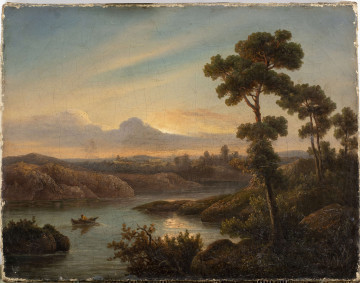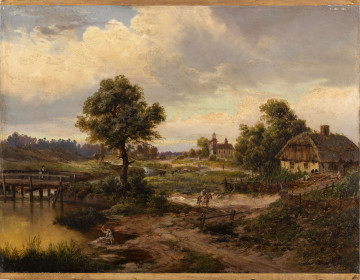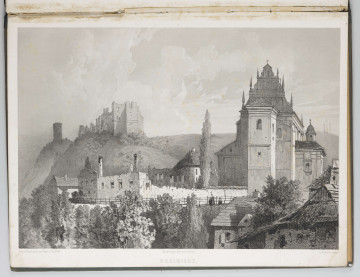
Landscape with the water
1862
National Museum in Lublin
Part of the collection: Polish landscape painting (19th–1st half of the 20th c.)
The painting shows the remains of the once magnificent seat of the powerful family of Ruthenian Ostrogski dukes. Its beginnings are connected with Daniel Ostrogski, who fought for the Duchy of Halicko-Vladimir. In the middle of the 14th century, he built the first and simultaneously the most important building of the fortress, visible on the right side of the picture – the round residential Brick Tower. Later, other defensive elements were added, including a magnificent church – the Cathedral of the Epiphany and other towers and bastions. The castle's heyday came at the turn of the 16th and 17th centuries when the Ostrogski family became one of the most wealthy and influential families of Lithuania and the Republic. Its last great representative was Wasyl Ostrogski, who, as a supporter of the Polish-Lithuanian Union was immortalised with his son by Matejko in the painting Unia Lubelska [Union of Lublin]. After Wasyl's death, the family lost its importance, and the residence did not resist the attacks of Cossack armies. Destroyed by Chmielnicki's army, it remained a ruin for a long time.
The author of the painting is Adam Malinowski, born in Lublin in 1829. He received his artistic education first in his hometown, among others in his father's goldsmith's workshop, and around mid-century he left for further studies in Warsaw and Vienna. While studying there he worked in theatres creating decorations for theatre and opera performances. After returning to Poland, he continued this kind of work, achieving considerable success; in 1872, he became the chief decorator of the Warsaw Government Theatres – Grand, Variety and Summer. At the same time, he dealt with easel painting. His favourite genre was landscape. He painted views of Kujawy, Lubelszczyzna and Wołyń, often shown at dusk. They are characterised by linear, meticulous depiction and slight, almost monochromatic colouring. Atmospheric nocturnes with the motif of cottages, mills and castle ruins against the background of picturesque nature, complemented by charming details, evoke associations with the 17th-century Dutch landscape. The representation of Ostrog Castle is maintained in such an atmosphere. It also belongs to a specific trend in 19th-century Polish painting, the so-called historical landscape. It was initiated by Zygmunt Vogel on the initiative of King Stanisław August and consisted in preserving architectural monuments significant for culture and history.
Bożena Kasperowicz
Author / creator
Dimensions
cały obiekt: height: 90 cm, width: 70 cm
Object type
painting
Technique
oil technique
Material
oil-based paint, canvas
Creation time / dating
Creation / finding place
Owner
The National Museum in Lublin
Identification number
Location / status

1862
National Museum in Lublin

1897
National Museum in Lublin

1860
National Museum in Lublin
DISCOVER this TOPIC
Castle Museum in Łańcut
DISCOVER this PATH
Educational path